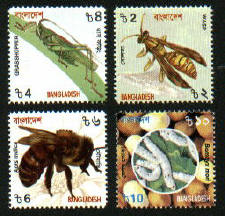Imidacloprid, one of the most widely used neonicotinoid pesticides, has been named as the likely culprit in the sharp worldwide decline in honey bee colonies since 2006. Researchers at the Harvard School of Public Health say their new research provides “convincing evidence” of the link between imidacloprid and colony collapse disorder. “It apparently doesn't take much of the pesticide to affect the bees,” says Alex Lu, associate professor of environmental exposure biology at Harvard’s Department of Environmental Health, “Our experiment included pesticide amounts below what is normally present in the environment.” The Harvard team’s research results will appear in the June issue of the Bulletin of Insectology (article attached). Lu and his research team hypothesized that the rise in CCD resulted from the presence of imidacloprid, a neonicotinoid introduced in the early 1990s. Bayer CropScience has reviewed the study. According to the company, the study is factually inaccurate and is seriously flawed, both in its methodology and conclusions. In stark contrast, Dutch toxicologist Henk Tennekes says that Alex Lu and co-workers have demonstrated that there is no safe imidacloprid dose for bees, and that this crucial discovery should lead to an immediate ban on the neonicotinoids. The alternative is an environmental catastrophe that is going to affect us all, the toxicologist says. "The data, both ours and others, right now merits a global ban," said Alex Lu."I would suggest removing all neonicotinoids from use globally for a period of five to six years. If the bee population is going back up during the after the ban, I think we will have the answer." The leader of one of the Science studies, Mickaël Henry, at INRA in Avignon, France, agreed with Lu that action is urgently needed on neonicotinoids. "We now have enough data to say authorisation processes must take into account not only the lethal effects, but also the effects of non-lethal doses." In other words, testing whether the pesticide use kills bees stone dead immediately is no longer good enough, given the hard evidence now available that sub-lethal doses cause serious harm. The Xerces Society for Invertebrate Conservation recently published a review of research into the effects of neonicotinoid insecticides on bees, with recommendations for action (attached).
Bees can be exposed in two ways – through nectar and pollen from treated plants or through high-fructose corn syrup which beekeepers use to feed their bees. As most U.S.-grown corn (maize) is treated with Imidacloprid when it is planted, imidacloprid is also found in corn syrup derived from those plants. In the summer of 2010, the researchers conducted an in situ study in Worcester County, Massachussetts, aimed at replicating how imidacloprid may have caused the CCD outbreak. Over a 23-week period, they monitored bees in four different bee yards; each yard had four hives treated with different levels of imidacloprid and each yard contained one un-treated ‘control’ hive. After 12 weeks of imidacloprid dosing, all the bees were alive. But after 23 weeks, 15 out of 16 of the imidacloprid-treated hives – 94% – had died. Those exposed to the highest levels of the pesticide died first. Lu says the characteristics of the dead hives were consistent with CCD – the hives were empty except for food stores, some pollen, and young bees, with few dead bees nearby. When other conditions cause hive collapse—such as disease or pests—many dead bees are typically found inside and outside the affected hives.
Strikingly, said Lu, it took only low levels of imidacloprid to cause hive collapse, less than what is typically used in crops or in areas where bees forage.
Sources: PRESS RELEASE – HARVARD SCHOOL OF PUBLIC HEALTH, Apr 5th -2012
http://news.harvard.edu/gazette/story/2012/04/pesticide-tied-to-bee-col…
The Independent, 6 April 2012
http://www.independent.co.uk/environment/nature/new-pesticide-link-to-s…
Science News, 6 April 2012
http://www.sciencenews.org/view/generic/id/339726/title/Yet_another_stu…
Video from WCVB TV (Boston), 5 April 2012:
http://www.thebostonchannel.com/health/30838824/detail.html
Daily Mail, 8 April 2012
http://www.dailymail.co.uk/news/article-2125952/Pesticide-linked-worryi…
The Guardian, 11 April 2012
http://www.guardian.co.uk/environment/damian-carrington-blog/2012/apr/1…
Bayer CropScience review of the study:
http://www.croplife.com/article/26607/bayer-says-bee-study-is-seriously…

- Log in to post comments

There is no safe imidacloprid dose for bees
The study by Alex Lu and co-workers establishes a relationship between the total imidacloprid dose (bees were exposed to) and the time to adverse effect on bees (Table 1 and 3, and Figure 2). The authors observe that the higher the exposure concentration, the earlier the adverse effect on bees occurs (Table 3, Figure 2). However, the total imidacloprid dose required for an adverse effect on bees to occur decreases with decreasing exposure levels (Table 1). This is exactly what the Druckrey-Kuepfmueller equation predicts, as explained in the 2010 paper by Dutch toxicologist Henk Tennekes in the journal Toxicology (attached). So, in effect Lu et al. prove that this equation describes the toxicity of imidacloprid to bees. The Druckrey-Kuepfmueller equation was first demonstrated to describe the effects of chemical carcinogens (for which no safe levels of exposure can be defined). Accordingly, the paper by Lu et al. provides irrefutable evidence that there is no safe level of exposure to imidacloprid for bees, and that any amount of imidacloprid will cause damage. This crucial discovery should lead to an immediate ban on the neonicotinoids. The alternative is an environmental catastrophe that is going to affect us all.